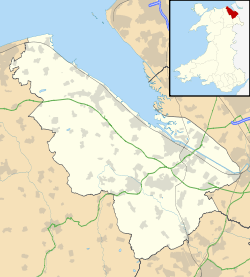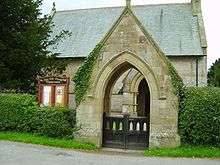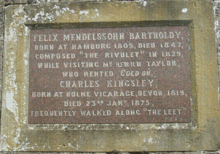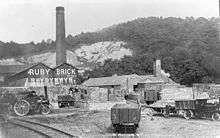Rhydymwyn
| Rhydymwyn | |
 Post office at Rhydymwyn |
|
 Rhydymwyn |
|
| Population | 537 (2011 Census) |
|---|---|
| OS grid reference | SJ205665 |
| Principal area | Flintshire |
| Ceremonial county | Clwyd |
| Country | Wales |
| Sovereign state | United Kingdom |
| Postcode district | CH7 |
| Dialling code | 01352 |
| Police | North Wales |
| Fire | North Wales |
| Ambulance | Welsh |
| EU Parliament | Wales |
| UK Parliament | Delyn |
| Welsh Assembly | Delyn |
|
|
Coordinates: 53°10′48″N 3°11′24″W / 53.18000°N 3.19000°W
Rhydymwyn (the name in Welsh means 'Ford of the Ore' and takes its placename from the ford across the River Alyn now replaced by a small iron bridge) is a village in Flintshire, Wales, located in the upper Alyn valley. Once a district of Mold, it was recognised as a separate parish from 1865. It is now part of the community of Cilcain.
Geography
The geology of the area consists of a layer of extremely pure, and hence structurally sound, 200 feet (61 m) thick layer of limestone at depths ranging from surface to 900 feet (270 m).[1] The limestone holds other minerals, including copper, nickel and copper deposits, making it an ideal site for mining.
History
Due to the industrialisation of nearby Northwest England, and its needs for mineral supplies, the mineral deposits in the Alyn valley created a population explosion in various villages, including Rhydymwyn. From the mid-18th century, Rhydymwyn was the site for a range of industries, which included foundries, waterwheels as well as mine workings.[2]

The new parish of Rhydymwyn was created on 31 March 1865, comprising: parts of the townships of Gwysaney and Gwernaffield, formerly in the parish of Mold; parts of the townships of Cefn and Glust (or Llysdianhunedd), and the whole of the township of Mechlas, formerly in the parish of Cilcain; and part of the township of Caerfallwch, formerly in the parish of Northop. The foundation stone of the new parish church, dedicated to St. John the Evangelist, was laid on 1 August 1861, and the church was consecrated on 17 September 1864.[3] It has been designated a grade II* listed building.[4]
The Denbigh and Mold Junction Railway had a Rhydymwyn station on the south side of A541, which opened on 6 September 1869.[5] The station closed to passengers on 30 April 1962 and completely from 4 May 1964. The former station building is now a private house.[6]
Ffynnon leinw
Approximately 1 mile (1.6 km) from Rhydymwyn is the small hamlet of Hendre. Along the main road from the old Sardis Chapel, and only a few feet from the edge of the A541 there is an ancient well - Ffynnon leinw - (leinw comes from the Welsh word "llanw" meaning tide as it is reported that the water in the well rose and ebbed with the tides of the Dee Estuary). The well has been listed as one of the holy wells of Wales on a par with the more famous St Winefride's Well in Holywell. The well in Hendre is mentioned by Thomas Pennant in his 'A Tour in Wales' - written between 1778–1783 and also by Giraldus Cambrensis or Gerald of Wales in his 'Journey through Wales' written in 1188 - an itinerary of his journeys as he accompanied Archbishop Baldwin of Exeter to enlist support for the Third Crusade.

Mendelssohn and Charles Kingsley
The famous German composer Felix Mendelssohn Bartholdy composed The Rivulet in 1829 while visiting his father's friend John Taylor (himself a famous mining engineer and entrepreneur) and his family in 1829 who rented Coed Du. This work was inspired by the beauty of the countryside. During the same visit, Mendelssohn composed his operetta Son and Stranger.[7]
Charles Kingsley, author of The Water-Babies, A Fairy Tale for a Land Baby, also came and walked the Leete; both his and Mendelssohn's visits are commemorated by a plaque in Nant Alyn Road, Rhydymwyn.
Recent times
In the autumn of 2000, local rainfall was exceptional in terms of intensity and duration. Between 28 October and 6 November, 68 homes and 8 businesses flooded in Rhydymwyn because of overflow from the River Alyn. In 2002 and 2003, DEFRA's internal team in two phases created a flood alarm and protection scheme to protect the whole village and Valley Works, with a level of protection in excess of a flood with a 1% chance of occurring in any one year. The total cost for the scheme was £88,000.[8]
Valley works

The Rhydymwyn Valley Site has an important history. During the early 19th century the site included an important iron foundry. Copper mining, iron working and agriculture have all added to the varied history of the area. The Rhydymwyn Valley Site was renamed in 1939 and became M.S.Factory Valley and was involved in the manufacture, assembly and storage of chemical weapons from 1940–1959 and later became a bulk storage depot for emergency supplies. The site of the Valley Works has now been returned to nature, attracts a wide variety of wildlife and is now designated as a nature reserve as outlined on a plaque at the entrance gates.
The Rhydymwyn Valley Nature Reserve
Valley has not been used since the mid-1990s. In the preceding postwar period many of the buildings were still in use, mainly as a buffer storage depot, but some were demolished because they were considered dangerous. The site has become a Nature Reserve and a Visitor Centre was built on the site of the old gatehouse.
The site covers 86 acres (350,000 m2) to the south of the village in a U shaped valley. The site was once the home to ancient copper mines and a 19th-century metal foundry. The western side of the site is semi-ancient deciduous woodland with an understorey of wild garlic, snowdrops, bluebells and orchids. The River Alyn flows in from the north west corner of the site and follows the western side of the valley. The river originally meandered through the centre of the valley but it was diverted as part of the early construction works. The river was canalised and given steep concrete sides and a concrete base. The middle section of the river is culverted underground for two sections. The site is now home to 7 herptile species, 8 species of fish, 17 species of butterfly/moth and 8 species of bat. 67 bird species have nested or been observed on the site.
The site is guarded by Carillion Facilities Management (CFM) who have provided these services to the Rhydymwym site since 1992. but managed access is encouraged and it is now extensively used by visiting parties. North East Wales Wildlife are contracted to manage the nature reserve and welcome visitors from school age upwards. Friends of Rhydymwyn Valley is a community group with an interest in the protection and encouragement of the flora and fauna within the Rhydymwyn Nature reserve and in the history of the Rhydymwyn Valley, and its members have access to the Reserve and welcome visitors. The Valley History Society also regularly arrange guided tours including access to the tunnel complex. Visits to the site can be arranged through the Visitor Centre.
References
- ↑ Davies, Ian (1997). "Rhydymwyn: History". Subterranea Britannica. Retrieved 2008-09-18.
- ↑ "WWII secret weapons site". BBC Wales. Retrieved 2008-09-18.
- ↑ "Rhydymwyn, Flintshire". GenUKI. Retrieved 2008-09-18.
- ↑ "Church of St John, Church Lane, Rhydwymyn, Cilcain". British Listed Buildings. Retrieved 9 January 2014.
- ↑ "Mold and Denbigh Junction Railway". RailScot. Retrieved 2008-09-18.
- ↑ "Disused stations - Rhydymwyn". Subterranea Britannica. Retrieved 2008-09-18.
- ↑ Davies, Rhian, "Mendelssohn in Mold," BBC Northeast Wales site, accessed November 23, 2009
- ↑ "Rhydymwyn Flood Alleviation Scheme". Environment Agency. Retrieved 2012-07-29.
External links
| Wikimedia Commons has media related to Rhydymwyn. |
- grid reference SJ2066
- Rhydymwyn memories, Government film from the 40s @ BBC Wales
- Pictures of Rhydymwyn on geograph.org.uk
- Rhydymwyn and Hendre Community Group Website
- Rhydymwyn Valley History Society
- North East Wales Wildlife